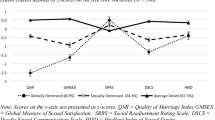Abstract
Sexual desire discrepancies and the associationsbetween desire discrepancies and relationship adjustment(i.e., sexual and relationship satisfaction) inheterosexual dating couples (N = 72) were examined. Desire discrepancies were assessed via twomethods: (1) a couple-based index created using bothindividuals' reports of sexual desire and (2) anindividual-based index using each person's ownsubjective perception of a desire discrepancy within thecouple. Both indices were associated with women'sadjustment, whereas only individual perceptions ofdiscrepancies were associated with men's adjustment. The association between desire discrepancies andgeneral relationship satisfaction was fully mediated bylevel of sexual satisfaction for both men and women.Women whose sexual desire level was lower than their partners' endorsed lower levels of relationshipadjustment relative to women whose desire was eithergreater than or similar to their partners'. Implicationsfor the assessment of sexual desire differences in couples are discussed.
Similar content being viewed by others
REFERENCES
American Psychiatric Association (1994). Diagnostic and Statistical Manual of Mental Disorders, 4th ed., APA, Washington, DC.
Apt, C., Hurlbert, D. F., Pierce, A. P., and White, L. C. (1996). Relationship satisfaction, sexual characteristics and the psychosocial well-being of women. Can. J. Hum. Sex. 5: 195–210.
Beck, J. G. (1995). Hypoactive sexual desire disorder: An overview. J. Consult. Clin. Psychol. 63: 919–927.
Beck, J. G., Bozman, A.W., and Qualtrough, T. (1991). The experience of sexual desire: Psychological correlates in a college sample. J. Sex Res. 28: 443–456.
Buss, D. M., Larsen, R. J., Westen, D., and Senmelroth, J. (1992). Sex differences in jealousy: Evolution, physiology, and psychology. Psychol. Sci. 3: 251–255.
Donahey, K. M., and Carroll, R. A. (1993). Gender differences in factors associated with hypoactive sexual desire. J. Sex Marital Ther. 19: 25–40.
Henderson-King, D., and Veroff, J. (1994). Sexual satisfaction and marital well-being in the first years of marriage. J. Soc. Pers. Relation. 11: 509–534.
Hendrix, S. S. (1988). A generic measure of relationship satisfaction. J. Marriage Family 50: 93–98.
Hudson, W. W., Harrison, D. F., and Crosscup, P. C. (1981). A short-form scale to measure sexual discord in dyadic relationships. J. Sex Res. 17: 157–174.
Hurlbert, D. F., and Apt, C. (1994a). What constitutes sexual satisfaction? Directions for future research. Sex. Marital Ther. 9: 285–289.
Hurlbert, D. F., and Apt, C. (1994b). Female sexual desire, response, and behavior. Behav. Modif. 18: 488–504.
Hurlbert, D. F., Apt, C., and Rabehl, S. M. (1993). Key variables to understanding female sexual satisfaction: An examination of women in nondistressed marriages. J. Sex Marital Ther. 19: 154–165.
Levine, S. B. (1987). More on the nature of sexual desire. J. Sex Marital Ther. 13: 35–44.
Levine, S. B. (1995). The vagaries of sexual desire. In Rosen, R. C., and Leiblum, S. R. (eds.), Case Studies in Sex Therapy, Guilford Press, New York, pp. 96–109.
LoPiccolo, J., and Friedman, J. M.(1988). Broad-spectrum treatment of lowsexual desire: Integration of cognitive, behavioral, and systemic therapy. In Leiblum, S. R., and Rosen, R. C. (eds.), Principles and Practice of Sex Therapy; Update for the 1990s, Guilford Press, New York, pp. 107–144.
Morokoff, P. J., and Gillilland, R. (1993). Stress, sexual functioning, and marital satisfaction. J. Sex Res. 30: 43–53.
Oliver, M. B., and Hyde, J. S. (1993). Gender differences in sexuality: A meta analysis. Psychol. Bull. 114: 29–51.
Purnine, D. M., and Carey, M. P. (1997). Interpersonal communication and sexual adjustment: The roles of understanding and agreement. J. Consult. Clin. Psychol. 65: 1017–1025.
Regan, P. C., and Berscheid, E. (1995). Gender differences in beliefs about the causes of male and female sexual desire. Pers. Relation. 2: 345–358.
Regan, P. C., and Berscheid, E. (1996). Beliefs about the state, goals, and objects of sexual desire. J. Sex Marital Ther. 22: 110–120.
Rosen, R. C., and Leiblum, S. R. (1989). Assessment and treatment of desire disorders. In Leiblum, S. R., and Rosen, R. C. (eds.), Principles and Practice of Sex Therapy; Update for the 1990s, Guilford Press, New York, pp. 19–47.
Rust, J., Golombok, S., and Collier, J. (1988). Marital problems and sexual dysfunction: How are they related? Br. J. Psychiatry 152: 629–631.
Spector, I. P., Carey, M. P., and Steinberg, L. (1996). The Sexual Desire Inventory: Development, factor structure, and evidence of reliability. J. Sex Marital Ther. 22: 175–190.
Stone Fish, L., Busby, D., and Killian, K. (1994). Structural couple therapy in the treatment of inhibited sexual desire. Am. J. Family Ther. 22: 113–123.
Stuart, F. M., Hammond, D. C., and Pett, M. A. (1987). Inhibited sexual desire in women. Arch. Sex. Behav. 16: 91–106.
Trudel, G., Boulos, L., and Matte, B. (1993). Dyadic adjustment in couples with hypoactive sexual desire disorder. J. Sex Educ. Ther. 19: 31–36.
Trudel, G., Landry, L., and Larose, Y. (1997). Low sexual desire: The role of anxiety, depression, and marital adjustment. Sex. Marital Ther. 12: 95–99.
Zilbergeld, B., and Ellison, C. R. (1980). Desire discrepancies and arousal problems in sex therapy. In Leiblum, S. R., and Pervin, L. A. (eds.), Principles and Practice of Sex Therapy, Guilford Press, New York.
Rights and permissions
About this article
Cite this article
Davies, S., Katz, J. & Jackson, J.L. Sexual Desire Discrepancies: Effects on Sexual and Relationship Satisfaction in Heterosexual Dating Couples. Arch Sex Behav 28, 553–567 (1999). https://doi.org/10.1023/A:1018721417683
Issue Date:
DOI: https://doi.org/10.1023/A:1018721417683




